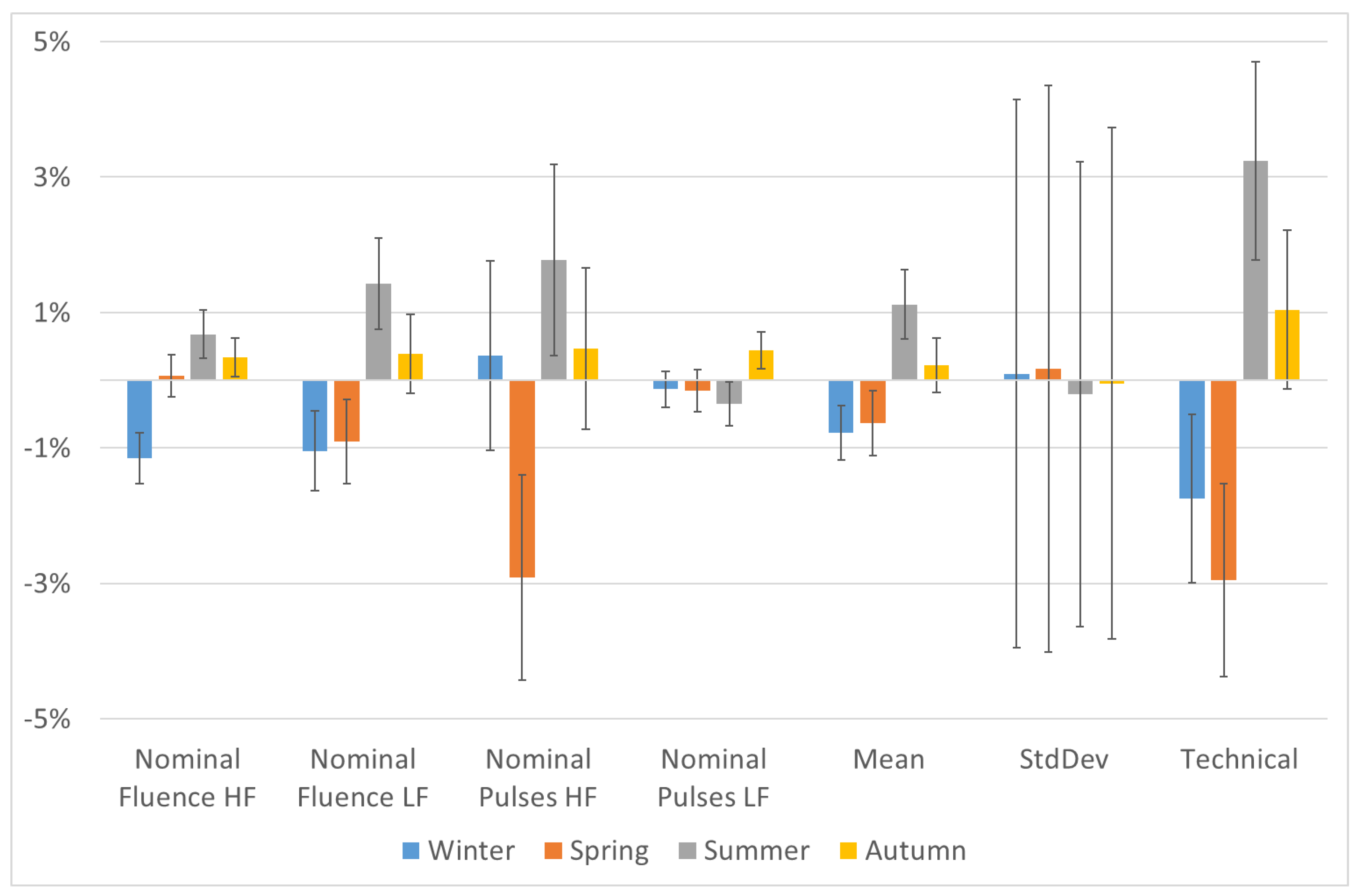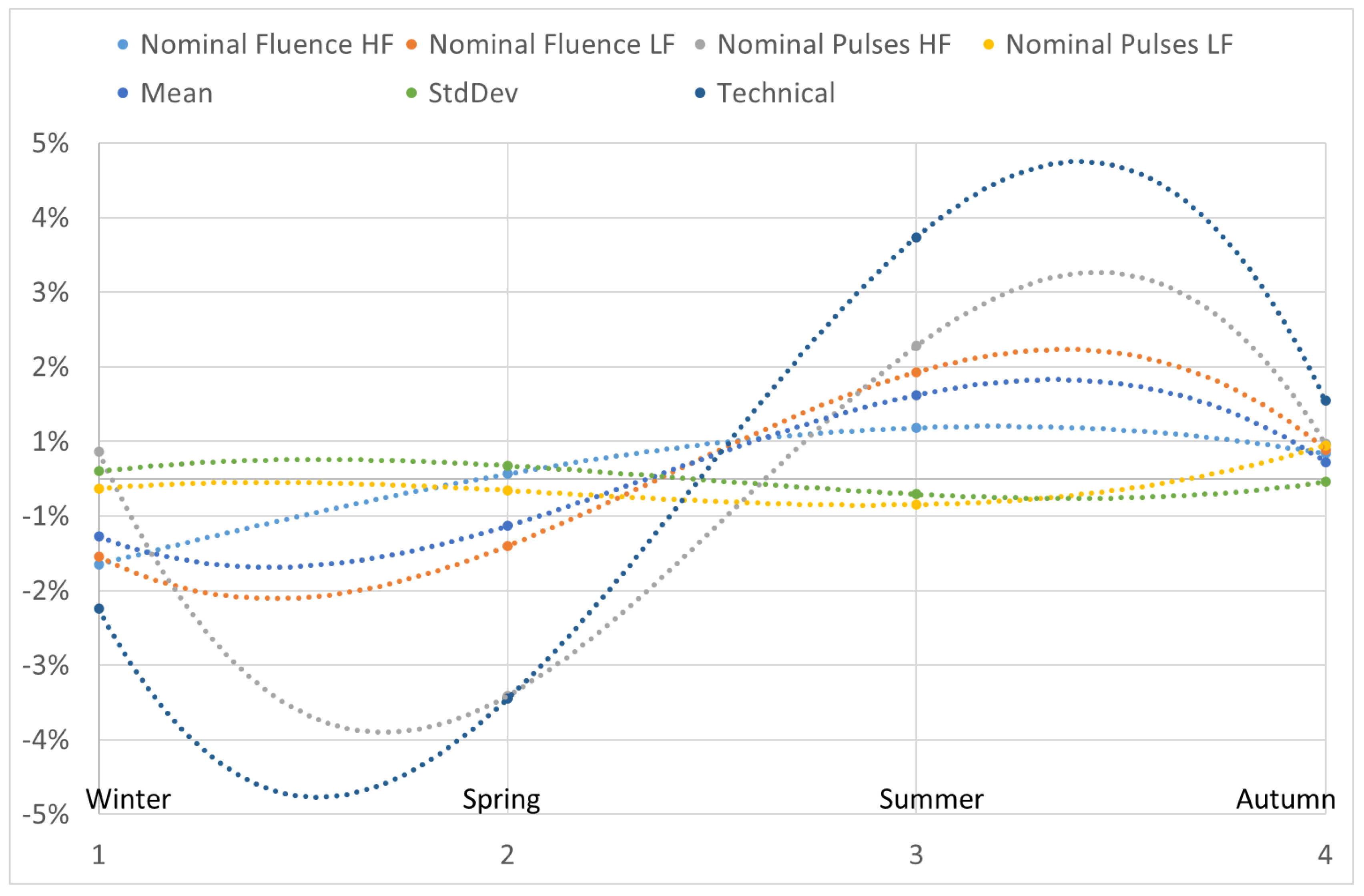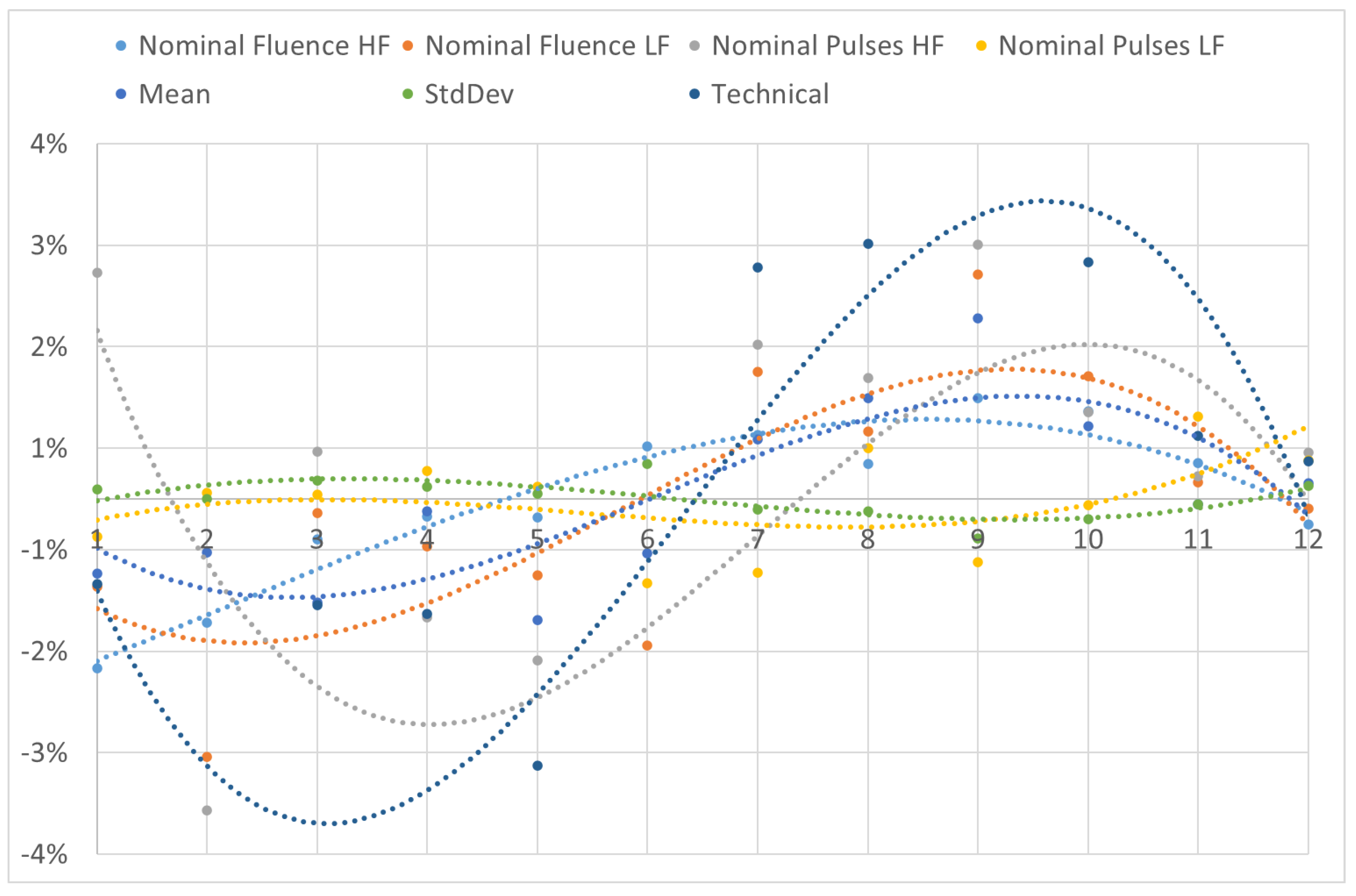Cross Sectional Analysis of Impact of Seasonal Changes on Excimer Laser Ablation Performance on Polymethyl Methacrylate (PMMA)
Abstract
1. Introduction
2. Materials and Methods
- Since the standard PMMA test comprises of 12 different ablations [15], for each laser system the mean performance and standard deviation in all the ablations was calculated.
- There are two energy levels used in the AMARIS laser system (High Fluence value of 1.0 mJ (~450 mJ/cm2) and Low Fluence value of 0.7 mJ (~300 mJ/cm2)). For each laser system, nominal number of laser pulses (determined with PET ablations) and nominal single laser pulse fluence (determined with PMMA ablations) were recorded for both the energy settings.
- Based on the distribution of the two energy settings in the AMARIS laser system, and the measured nominal single pulse fluence and nominal number of laser pulses, the overall system performance was calculated for each laser system and termed as the ‘technical’ performance of the system.
- The parameters analyzed in the following steps were: nominal single laser pulse fluence (high fluence and low fluence), nominal number of laser pulses (high fluence and low fluence), mean performance (in 12 PMMA ablations per system), standard deviation (in 12 PMMA ablations per system), and technical performance of the system (comprising distribution of the two energy levels). For each of these parameters, the global average was calculated as the average value obtained for all the laser systems under analysis.
- The lasers were stratified depending on the season of the year and depending on the months of the year.
- Student’s T-test was performed to statistically compare the stratified values of the parameters based on the season/month of the year, with the global average values of the parameters. The level of statistical significance was set to p ≤ 0.05. The normality of the data was verified through ‘back of the envelope test’.
- Percentage deviation in stratified values of each parameter was calculated with respect to the global average values. Based on the deviation, underperformance (meaning relatively shallower ablation, less-than-planned correction) or overperformance (meaning relatively deeper ablation, more-than-planned correction) in terms of ablation was assessed.
3. Results
3.1. Seasonal Influence
3.2. Seasonal Influence-Stratification on Months of a Year
4. Discussion
Author Contributions
Funding
Institutional Review Board Statement
Informed Consent Statement
Data Availability Statement
Acknowledgments
Conflicts of Interest
References
- Probst, L. Environmental factors and LASIK. J. Cataract Refract. Surg. 2004, 30, 1817–1818. [Google Scholar] [CrossRef]
- Neuhaus-Richard, I.; Frings, A.; Ament, F.; Görsch, I.C.; Druchkiv, V.; Katz, T.; Linke, S.J.; Richard, G. Variation in the effectiveness of refractive surgery during the year: Results from the Hamburg Weather Study. J. Cataract Refract. Surg. 2014, 40, 1139–1146. [Google Scholar] [CrossRef]
- Dantas, P.E.; Martins, C.L.; de Souza, L.B.; Dantas, M.C. Do environmental factors influence excimer laser pulse fluence and efficacy? J. Refract. Surg. 2007, 23, 307–309. [Google Scholar] [CrossRef]
- Patel, S.; Alió, J.L.; Walewska, A.; Amparo, F.; Artola, A. Patient age, refractive index of the corneal stroma, and outcomes of uneventful laser in situ keratomileusis. J. Cataract Refract. Surg. 2013, 39, 386–392. [Google Scholar] [CrossRef] [PubMed]
- Patel, S.; Alió, J.L.; Artola, A. Changes in the refractive index of the human corneal stroma during laser in situ keratomileusis. Effects of exposure time and method used to create the flap. J. Cataract Refract. Surg. 2008, 34, 1077–1082. [Google Scholar] [CrossRef] [PubMed]
- Dorronsoro, C.; Schumacher, S.; Pérez-Merino, P.; Siegel, J.; Mrochen, M.; Marcos, S. Effect of air-flow on the evaluation of refractive surgery ablation patterns. Opt. Express 2011, 19, 4653–4666. [Google Scholar] [CrossRef] [PubMed][Green Version]
- Szekrényesi, C.; Kiss, H.; Filkorn, T.; Nagy, Z.Z. Shielding effect of the smoke plume by the ablation of excimer lasers. BMC Ophthalmol. 2018, 18, 273. [Google Scholar] [CrossRef] [PubMed]
- Seider, M.I.; McLeod, S.D.; Porco, T.C.; Schallhorn, S.C. The effect of procedure room temperature and humidity on LASIK outcomes. Ophthalmology 2013, 120, 2204–2208. [Google Scholar] [CrossRef]
- Schipper, I. Effect of environmental factors on myopic laser in situ keratomileusis enhancement rates. J. Cataract Refract. Surg. 2004, 30, 2257. [Google Scholar] [CrossRef]
- Luger, M.H.; Ewering, T.; Arba-Mosquera, S. Analysis of seasonal changes in residual refraction 1-year after corneal laser refractive surgery: A retrospective study. J. Optom. 2014, 7, 138–146. [Google Scholar] [CrossRef][Green Version]
- Walter, K.A.; Stevenson, A.W. Effect of environmental factors on myopic LASIK enhancement rates. J. Cataract Refract. Surg. 2004, 30, 798–803. [Google Scholar] [CrossRef] [PubMed]
- Kim, W.S.; Jo, J.M. Corneal hydration affects ablation during laser in situ keratomileusis surgery. Cornea 2001, 20, 394–397. [Google Scholar] [CrossRef] [PubMed]
- Chatterjee, A.; Shah, S. Seasonal variations in refractive results following excimer laser photorefractive keratectomy. J. Refract Surg. 1997, 13, S447–S449. [Google Scholar] [CrossRef] [PubMed]
- Gottsch, J.D.; Rencs, E.V.; Cambier, J.L.; Hall, D.; Azar, D.T.; Stark, W.J. Excimer laser calibration system. J. Refract. Surg. 1996, 12, 401–411. [Google Scholar] [CrossRef]
- Arba-Mosquera, S.; Vinciguerra, P.; Verma, S. Review of technological advancements in calibration systems for laser vision correction. J. Biomed. Opt. 2018, 23, 020901. [Google Scholar] [CrossRef]
- Mrochen, M.; Wuellner, C.; Rose, K.; Donitzky, C. Experimental setup to determine the pulse energies and radiant exposures for excimer lasers with repetition rates ranging from 100 to 1050 Hz. J. Cataract Refract. Surg. 2009, 35, 1806–1814. [Google Scholar] [CrossRef]
- Dorronsoro, C.; Cano, D.; Merayo-Lloves, J.; Marcos, S. Experiments on PMMA models to predict the impact of corneal refractive surgery on corneal shape. Opt. Express 2006, 14, 6142–6156. [Google Scholar] [CrossRef] [PubMed]
- Doga, A.V.; Shpak, A.A.; Sugrobov, V.A. Smoothness of ablation on polymethylmethacrylate plates with four scanning excimer lasers. J. Refract. Surg. 2004, 20, S730–S733. [Google Scholar] [CrossRef] [PubMed]
- Dorronsoro, C.; Siegel, J.; Remon, L.; Marcos, S. Suitability of Filofocon A and PMMA for experimental models in excimer laser ablation refractive surgery. Opt. Express 2008, 16, 20955–20967. [Google Scholar] [CrossRef]
- Anschutz, T.; Pieger, S. Correlation of laser profilometry scans with clinical results. J. Refract. Surg. 1999, 15, S252–S256. [Google Scholar]
- Vinciguerra, P.; Camesasca, F.I.; Munoz, M.I. New test hemisphere for evaluation and development of ablation profiles. J. Refract. Surg. 2003, 19, S260–S264. [Google Scholar] [CrossRef] [PubMed]
- Wernli, J.; Schumacher, S.; Wuellner, C.; Donitzky, C.; Mrochen, M. Initial surface temperature of PMMA plates used for daily laser calibration affects the predictability of corneal refractive surgery. J. Refract. Surg. 2012, 28, 639–644. [Google Scholar] [CrossRef] [PubMed]
- Arba Mosquera, S.; Shraiki, M. Analysis of the PMMA and cornea temperature rise during excimer laser ablation. J. Modern Opt. 2010, 57, 400–407. [Google Scholar] [CrossRef]
- Verma, S.; Kehrer, T.; Hesser, J.; Arba-Mosquera, S. Analysis of Impact of Humidity and Temperature on Excimer Laser Ablation of PET, PMMA and Porcine Corneal Tissue. Lasers Surg. Med. 2020, 52, 627–638. [Google Scholar] [CrossRef]




| Metric | Description | Typical Value (Units) | Impact |
|---|---|---|---|
| Nominal fluence HF | Calibrated spot depth of high energy pulse (1.0 mJ) | 710 nm | Lower values result in more pulses for a given treatment → Over correction |
| Nominal fluence LF | Calibrated spot depth of low energy pulse (0.7 mJ) | 570 nm | Lower values result in more pulses for a given treatment → Over correction |
| Nominal pulses HF | Calibrated number of high energy pulses required to go through the test material (PET) | 12,300 pulses | Lower values result in more pulses for a given treatment → Over correction |
| Nominal pulses LF | Calibrated number of low energy pulses required to go through the test material (PET) | 10,330 pulses | Lower values result in more pulses for a given treatment → Over correction |
| Mean Performance | Ratio between achieved and attempted refractive correction on test material (PMMA) | 100% | Lower values → Under correction |
| Standard Deviation | Standard deviation of the achieved vs. attempted refractive correction on test material (PMMA) | <4.0% | Lower values → Less variability |
| Technical Performance | Ratio between actual and theoretical performance on test material (PMMA) | 100% | Lower values → Under Performance |
| Months | Number of AMARIS Systems Analyzed | Seasons | Number of AMARIS Systems Analyzed |
|---|---|---|---|
| January | 85 | Winter | 196 |
| February | 48 | ||
| March | 63 | ||
| April | 56 | Spring | 180 |
| May | 62 | ||
| June | 62 | ||
| July | 68 | Summer | 184 |
| August | 51 | ||
| September | 65 | ||
| October | 76 | Winter | 266 |
| November | 118 | ||
| December | 72 |
| Value | Single Laser Pulse Fluence (HF) | Single Laser Pulse Fluence (LF) | Nominal Pulses (HF) | Nominal Pulses (LF) | Mean | Standard Deviation | Technical Performance |
|---|---|---|---|---|---|---|---|
| Season where the value was Lower than Global Average (p < 0.05) | Winter | Winter | Spring | Stable | Winter | Summer | Winter |
| Season where the value was higher than Global Average (p < 0.05) | Summer | Summer | Summer | Stable | Summer | Winter | Summer |
| Range or maximum deviation | 2% | 2% | 5% | 1% | 2% | 0% | 6% |
| Value | Single Laser Pulse Fluence (HF) | Single Laser Pulse Fluence (LF) | Nominal Pulses (HF) | Nominal Pulses (LF) | Mean | Standard Deviation | Technical Performance |
|---|---|---|---|---|---|---|---|
| Months where the value was Lower than global average (p < 0.05) | January–February | January–June | February–June | Stable | January–June | July–October | January–June |
| Months where the value was higher than global average (p < 0.05) | June–October | July–October | July–October | Stable | July–October | January–June | July–October |
| Range or maximum deviation | 3% | 5% | 9% | 1% | 3% | 1% | 10% |
Disclaimer/Publisher’s Note: The statements, opinions and data contained in all publications are solely those of the individual author(s) and contributor(s) and not of MDPI and/or the editor(s). MDPI and/or the editor(s) disclaim responsibility for any injury to people or property resulting from any ideas, methods, instructions or products referred to in the content. |
© 2023 by the authors. Licensee MDPI, Basel, Switzerland. This article is an open access article distributed under the terms and conditions of the Creative Commons Attribution (CC BY) license (https://creativecommons.org/licenses/by/4.0/).
Share and Cite
Verma, S.; Hesser, J.; Mosquera, S.A. Cross Sectional Analysis of Impact of Seasonal Changes on Excimer Laser Ablation Performance on Polymethyl Methacrylate (PMMA). Vision 2023, 7, 50. https://doi.org/10.3390/vision7030050
Verma S, Hesser J, Mosquera SA. Cross Sectional Analysis of Impact of Seasonal Changes on Excimer Laser Ablation Performance on Polymethyl Methacrylate (PMMA). Vision. 2023; 7(3):50. https://doi.org/10.3390/vision7030050
Chicago/Turabian StyleVerma, Shwetabh, Juergen Hesser, and Samuel Arba Mosquera. 2023. "Cross Sectional Analysis of Impact of Seasonal Changes on Excimer Laser Ablation Performance on Polymethyl Methacrylate (PMMA)" Vision 7, no. 3: 50. https://doi.org/10.3390/vision7030050
APA StyleVerma, S., Hesser, J., & Mosquera, S. A. (2023). Cross Sectional Analysis of Impact of Seasonal Changes on Excimer Laser Ablation Performance on Polymethyl Methacrylate (PMMA). Vision, 7(3), 50. https://doi.org/10.3390/vision7030050





